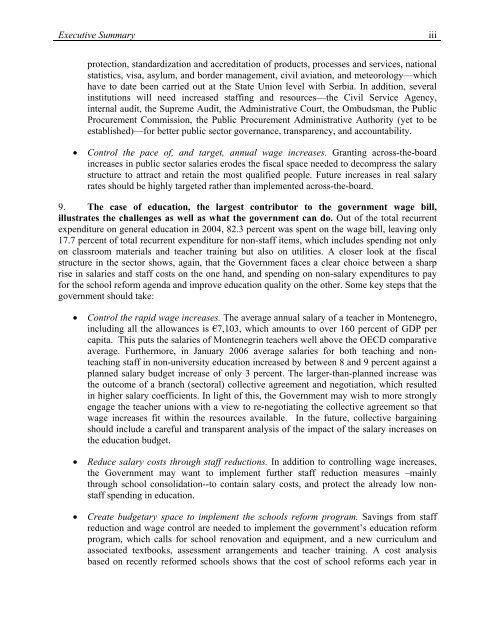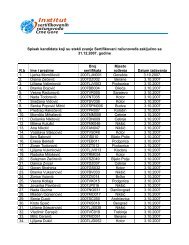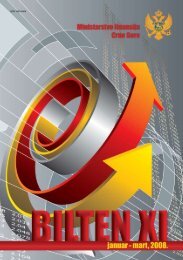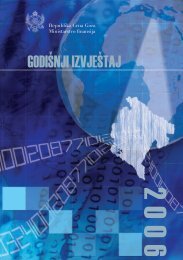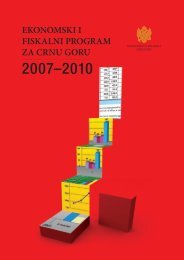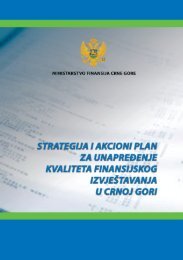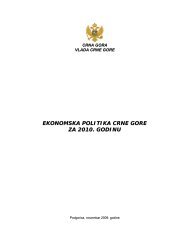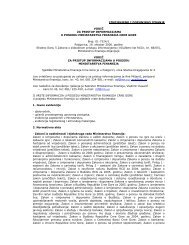Republic of Montenegro: Public Expenditure and ... - Vlada Crne Gore
Republic of Montenegro: Public Expenditure and ... - Vlada Crne Gore
Republic of Montenegro: Public Expenditure and ... - Vlada Crne Gore
You also want an ePaper? Increase the reach of your titles
YUMPU automatically turns print PDFs into web optimized ePapers that Google loves.
Executive Summary<br />
iii<br />
protection, st<strong>and</strong>ardization <strong>and</strong> accreditation <strong>of</strong> products, processes <strong>and</strong> services, national<br />
statistics, visa, asylum, <strong>and</strong> border management, civil aviation, <strong>and</strong> meteorology—which<br />
have to date been carried out at the State Union level with Serbia. In addition, several<br />
institutions will need increased staffing <strong>and</strong> resources—the Civil Service Agency,<br />
internal audit, the Supreme Audit, the Administrative Court, the Ombudsman, the <strong>Public</strong><br />
Procurement Commission, the <strong>Public</strong> Procurement Administrative Authority (yet to be<br />
established)—for better public sector governance, transparency, <strong>and</strong> accountability.<br />
• Control the pace <strong>of</strong>, <strong>and</strong> target, annual wage increases. Granting across-the-board<br />
increases in public sector salaries erodes the fiscal space needed to decompress the salary<br />
structure to attract <strong>and</strong> retain the most qualified people. Future increases in real salary<br />
rates should be highly targeted rather than implemented across-the-board.<br />
9. The case <strong>of</strong> education, the largest contributor to the government wage bill,<br />
illustrates the challenges as well as what the government can do. Out <strong>of</strong> the total recurrent<br />
expenditure on general education in 2004, 82.3 percent was spent on the wage bill, leaving only<br />
17.7 percent <strong>of</strong> total recurrent expenditure for non-staff items, which includes spending not only<br />
on classroom materials <strong>and</strong> teacher training but also on utilities. A closer look at the fiscal<br />
structure in the sector shows, again, that the Government faces a clear choice between a sharp<br />
rise in salaries <strong>and</strong> staff costs on the one h<strong>and</strong>, <strong>and</strong> spending on non-salary expenditures to pay<br />
for the school reform agenda <strong>and</strong> improve education quality on the other. Some key steps that the<br />
government should take:<br />
• Control the rapid wage increases. The average annual salary <strong>of</strong> a teacher in <strong>Montenegro</strong>,<br />
including all the allowances is €7,103, which amounts to over 160 percent <strong>of</strong> GDP per<br />
capita. This puts the salaries <strong>of</strong> Montenegrin teachers well above the OECD comparative<br />
average. Furthermore, in January 2006 average salaries for both teaching <strong>and</strong> nonteaching<br />
staff in non-university education increased by between 8 <strong>and</strong> 9 percent against a<br />
planned salary budget increase <strong>of</strong> only 3 percent. The larger-than-planned increase was<br />
the outcome <strong>of</strong> a branch (sectoral) collective agreement <strong>and</strong> negotiation, which resulted<br />
in higher salary coefficients. In light <strong>of</strong> this, the Government may wish to more strongly<br />
engage the teacher unions with a view to re-negotiating the collective agreement so that<br />
wage increases fit within the resources available. In the future, collective bargaining<br />
should include a careful <strong>and</strong> transparent analysis <strong>of</strong> the impact <strong>of</strong> the salary increases on<br />
the education budget.<br />
• Reduce salary costs through staff reductions. In addition to controlling wage increases,<br />
the Government may want to implement further staff reduction measures –mainly<br />
through school consolidation--to contain salary costs, <strong>and</strong> protect the already low nonstaff<br />
spending in education.<br />
• Create budgetary space to implement the schools reform program. Savings from staff<br />
reduction <strong>and</strong> wage control are needed to implement the government’s education reform<br />
program, which calls for school renovation <strong>and</strong> equipment, <strong>and</strong> a new curriculum <strong>and</strong><br />
associated textbooks, assessment arrangements <strong>and</strong> teacher training. A cost analysis<br />
based on recently reformed schools shows that the cost <strong>of</strong> school reforms each year in


